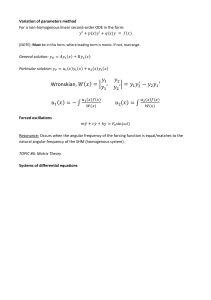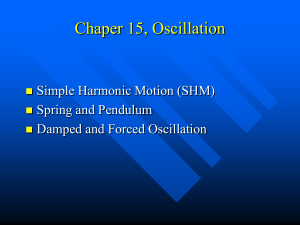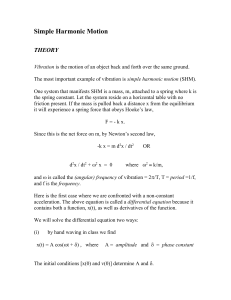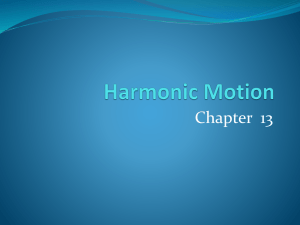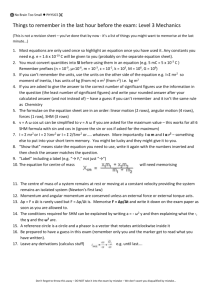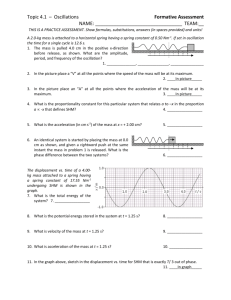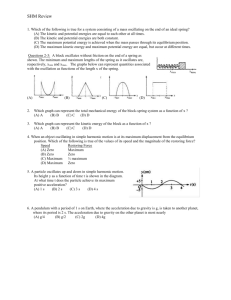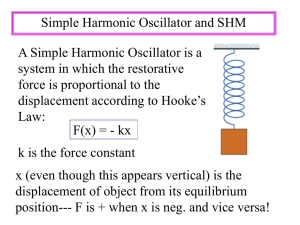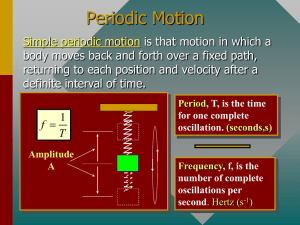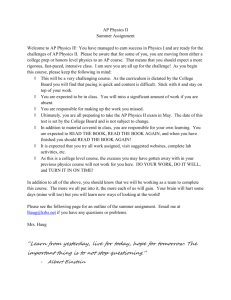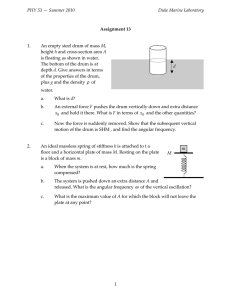Simple Harmonic Motion
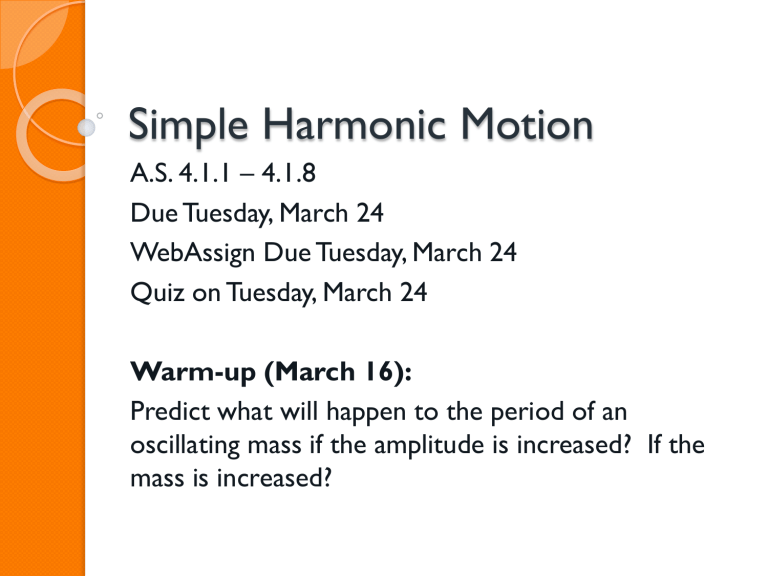
Simple Harmonic Motion
A.S. 4.1.1 – 4.1.8
Due Tuesday, March 24
WebAssign Due Tuesday, March 24
Quiz on Tuesday, March 24
Warm-up (March 16):
Predict what will happen to the period of an oscillating mass if the amplitude is increased? If the mass is increased?
Hooke’s Law
The force applied to a spring in order to extend or compress it is proportional to the amount of displacement of the spring from its rest position.
The spring force will be equal and opposite to the applied force, as it is a tension that is a reaction force to the applied force
𝑭
𝒔𝒑𝒓𝒊𝒏𝒈
= −𝒌𝒙
Elastic Limit
Once a spring has reached its elastic limit, it will not return to its original length.
Hooke’s Law only applies if a spring will return to its original position (length)
By definition: Elastic Limit is the maximum range of extension(or compression) for which Hooke’s law is satisfied.
SHM for a Mass on a Horizontal Spring
Rest Position: the position of the mass when it is experiencing no net force
Restoring Force: the force the spring applies to the mass in order to pull it back to the rest position.
◦ The strength of the force depends on the displacement of the mass and the spring constant of the spring.
Displacement: The change in position of the mass relative to its rest position
◦ The positive direction must be defined and kept constant for a system.
Conditions for SHM:
The equilibrium (rest) position must
be in a fixed position.
The acceleration of the mass must be proportional to and in the opposite
direction as its displacement.
𝐹 𝑛𝑒𝑡
= 𝐹 𝑠𝑝𝑟𝑖𝑛𝑔 𝑚𝑎 = −𝑘𝑥 𝑎 = − 𝑘 𝑚
∙𝑥
Angular Frequency (
w
)
Frequency, in general (linear frequency), is simply a count of how many times the mass reaches a set point per second.
◦ For an oscillation: The number of times per second an oscillating mass completes one full cycle (one full oscillation)
◦ In one oscillation, how does the motion compare to circular motion?
Angular Frequency puts the count found in linear Frequency in terms of the amount of radians the mass has covered per second.
Angular Frequency
How many radians does a mass oscillate through in one cycle?
How can the angular frequency and the linear frequency be mathematically related? (what’s the conversion equation?)
𝝎 = 𝟐𝝅𝒇
Quick Sample:
If a mass completed 30 full oscillations in
20.0 seconds, what is the angular frequency for this mass?
𝟑𝟎 𝒄𝒚𝒄𝒍𝒆𝒔 𝝎 = 𝟐𝝅𝒇 = 𝟐𝝅 = 𝟑𝝅 𝑟𝑎𝑑 ∙ 𝑠 −1
𝟐𝟎. 𝟎 𝒔𝒆𝒄
Angular frequency = 𝟑𝝅 𝑠 −1
Note: ANGULAR frequency is NOT measured in Hertz (Hz), and it is typically acceptable to leave it in terms of p .
Back to our spring:
What are the units for the ratio 𝑘 𝑚 𝒌 𝑁 𝑚 −1 𝑁
→ = 𝒎 𝑘𝑔
To what does this simplify?
𝑚 𝑘𝑔
?
𝑠 −2
Huh…this looks similar to the unit for angular frequency…
Which means, we can mathematically define w : 𝒌 𝒎
= 𝝎 𝟐
SHM Defining Equation
Review: what’s the mathematical condition for SHM to occur?
𝑎 = − 𝑘 𝑚
∙𝑥
What’s our definition of angular frequency?
𝒌
= 𝝎 𝟐 𝒎
Put them together, and you’ll get the
Defining Equation for SHM:
𝒂 = −𝝎
𝟐
𝒙
Fundamental Vocabulary:
Amplitude (A or x
0
): the maximum displacement from the equilibrium position during an oscillation
Period (T): The amount of time, in seconds, required for one full oscillation.
◦ Frequency is the mathematical inverse to the period:
1 𝑓 =
𝑇
Exploration lab:
You’ll be exploring the behavior of an object in simple harmonic motion, and will be observing the effect of a variety of variables on the period of the oscillations you see.
All observations will be done in your lab book, and you’ll be printing a few graphs and taping them in your books as well.
